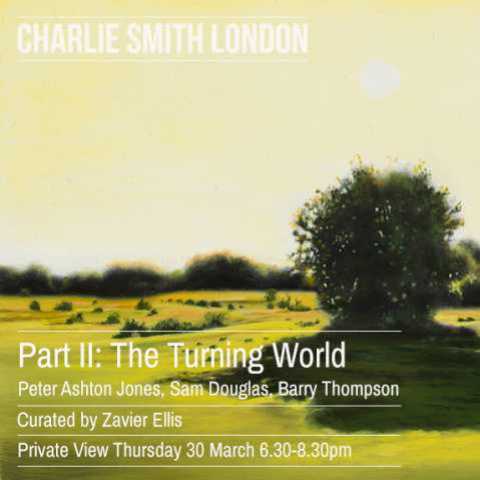CHARLIE SMITH LONDON
336 Old Street
London
EC1V 9DR
United Kingdom

EXHIBITION DATES
Friday 31 March - Saturday 6 May 2017
GALLERY HOURS
Wednesday-Saturday 11am-6pm or by appointment
CHARLIE SMITH LONDON presents the second in a trilogy of interconnected exhibitions.
'The Turning World' investigates the relevance of contemporary landscape painting in relation to the art historical, and our perception of it. Man's relationship with the land is dependent on geographical location and historical context. Circa 10,000 BC Homo sapiens transitioned from roaming bands of hunter gatherers to farming communities that settled in order to cultivate wheat. It is at this point that man began to fundamentally manipulate the landscape, and become reliant on a singular, fixed area. He learned to control the land, and the land came to control him.
In the Western art historical tradition, landscape painting evolved from being a background within which to set figures, into a subject in itself in the 16th century, specifically by artists such as Albrecht Altdorfer of the Danube School. By the 19th century landscape painting had become the dominant European genre, being significantly availed by the occurrence of Romanticism. Depictions of nature became the vehicle by which Romantic painters could express notions of awe, individuality, emotion, and the sublime.
It is in this context that we ask, what is a landscape?
Peter Ashton Jones approaches landscape formally, consciously relating to the idealised paintings of Titian, Bruegel and Corot. Beginning by making small pencil drawings en plein air where he grew up in the Sussex Downs, Ashton Jones renders his studio paintings by using the preparatory drawings for reference in combination with memory and experience of place. This allows for inevitable slippages between reality and the idea, thereby allowing for a fictionalisation of the landscape.
Ashton Jones' choice of subject is based on three principles: the dynamic of the composition; material possibilities; and the title, which will often reference the process of painting, such as 'The Passage' or 'The Edge'. Combined with his emphasis on the technical aspects of the materiality of oil paint, surface, glazing and brushwork, Ashton Jones objectifies the landscape and his experience of it, whilst simultaneously deploying landscape to objectify the process of painting.
Sam Douglas engages with the geological aspect of landscape and the structures found within it. His paintings depict the relationship between nature and man's actions upon it. Douglas accentuates the importance of being in the landscape by travelling and undertaking residencies, so that he can continuously add more primary source material to his practice. Just as the landscape reveals its history to those who can decode its physical aspects, Douglas' paintings are built layer upon layer over time, thus implying a set of hidden narratives formed by experiencing different landscapes at different times.
Douglas sets two parameters against each other: that of English pastoral painting and manmade industrial installations and infrastructure. Growing up in Somerset near the Hinkley Point nuclear power station, this apparently contrasting aspect of landscape is embedded within the artist's visual memory. With this in mind, Douglas' use of colour differentiates him from other landscape painters. Hinting at the psychedelic, his subtle use of intensified pastels and disrupted surfaces allude quietly to the consequences of industrialisation.
Barry Thompson makes impeccably rendered small scale landscapes in oil on panel where fact and fiction blur. Using photographs of locations in and around Dagenham, Essex, where he grew up, Thompson consciously manipulates colour, form and space to (re)create a lost or idealised past:
'The work put simply focuses on the past times of one's childhood and adolescence. By this I mean the landscape of these times both literally and psychologically. The place itself, what took place there, bird watching, playing soldiers, underage smoking, porn mags, dens, drugs, fields, trees, long grass, summer hide outs, late evenings, early mornings, the dawn chorus, music, being in a band, a whole litany of events and memories that are now traced through the act of painting and drawing.â€
Referencing significant personal moments, therefore, Thompson loads an aura of nostalgic longing into his paintings. There is also a suggestion of the revelatory, as the artist toys with visual tropes that have been employed by landscape painters throughout the centuries.
In combination, these three painters (only one of whom is predominantly a landscape painter) all draw on their personal experience of specific places to investigate the fictional nature of landscape. They ask us to question prima facie acceptance of contemporary and historical landscape imagery, and encourage us to consider misremembering, idealisation, reality and artifice. And by extension, we are urged to consider what is natural, and what is man-made, and what is, in fact, a landscape.
Please contact gallery for images and further information
